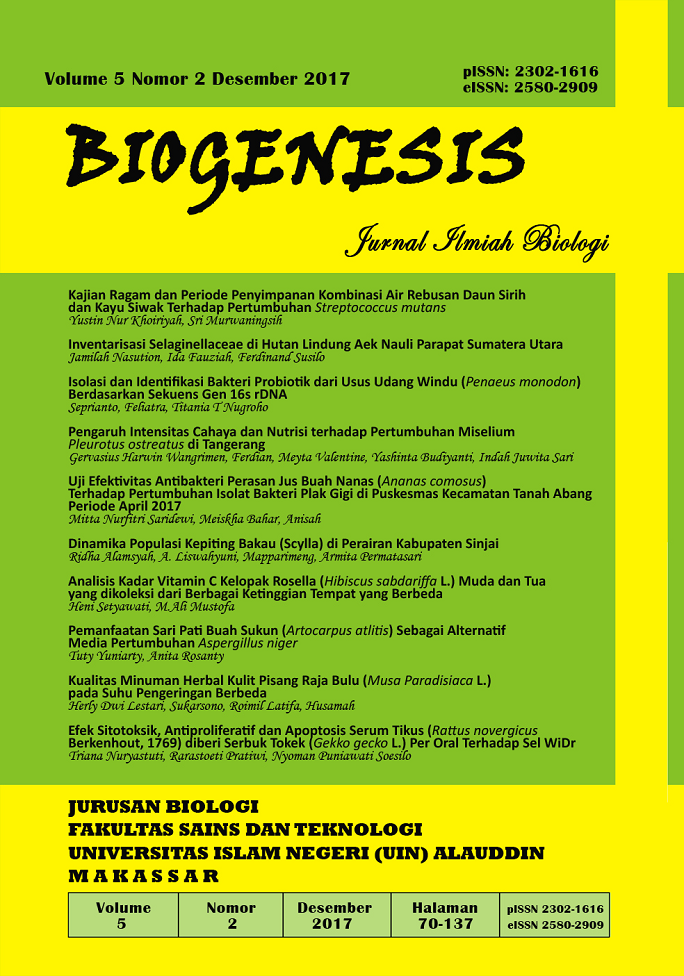Pengaruh Intensitas Cahaya dan Nutrisi Terhadap Pertumbuhan Miselium Pleurotus ostreatus di Tangerang
Abstrak
White oyster mushroom (Pleurotus ostreatus) is a type of beneficial mushroom, widely used for consumption, medicinal ingredients, as well as business-oriented cultivation. Nutrition and light intensity are two of the most influential factors for the growth of white oyster mushroom mycelium. Nutrients such as water used for rice cooking (traditionally called air leri) and glucose solution are thought to be potential sources of nutrients, but it is not known which nutrients are more suitable for the growth of white oyster mushroom mycelium. This research was conducted to find out the growth rate difference of white oyster mushroom mycelium produced by vary LED (Light-Emitting Diode) light intensity (sequentially 0 lux, 103 lux, 2x103 lux, 3x103 lux, and 4x103 lux ), air leri nutrition with a 1:1 dilution ratio, glucose solution with 1:3 ratio. Processed data showed that the growth rate of white oyster mushroom mycelium with air leri nutrition for 18 days is better than glucose solution, while low light intensity will affect the color to the growth rate of mycelium on the bag log medium.Referensi
Aliffahrana R. 2012. Respon Pertumbuhan Jamur Tiram Putih (Pleurotus ostreatus) pada Dua Kondisi Suhu dan Kelembaban Berbeda. [Tesis]. Bogor: Departemen Geofisika dan Meteorologi, Fakultas MIPA, Institut Pertanian Bogor. hal. 1-83.
Amelia F, Ferdinand J, Maria K, Waluyan MG, Sari IJ. 2017. Pengaruh Suhu dan Intensitas Cahaya Terhadap Pertumbuhan Jamur Tiram di Tangerang. Biogenesis. vol 5 (1): 1-6. https://doi.org/10.24252/bio.v5i1.3426
Ayu P. 2016. Budidaya Jamur Tiram. 1st ed. Bandung: Putra Danayu Publisher. hal. 2-5.
Chethana SH, Pratap B, Roy S, Jaiswal A, Shruthi SD, Vedamurthy AB. 2011. Bioethanol Production from Rice Water Waste: A Low Cost Motor Fuel. Pharmacologyonline. vol 3: 125-134.
Hadiyanto. 2012. Pengaruh Lingkungan Terhadap Pertumbuhan Jamur Tiram. Makalah Seminar PTH 1507. Lampung: Program Studi Hortikultura. Jurusan Budidaya Tanaman Pangan. Politeknik Negeri Lampung.
Handiyanto S, Hastuti US, Prabaningtyas S. 2013. Kajian Penggunaan Air Cucian Beras Sebagai Bahan Media Pertumbuhan Biakan Murni Jamur Tiram Putih (Pleurotus ostreatus var. Florida). Prosiding Seminar Biologi FKIP UNS. vol: 10(2): 1-8.
Kalsum U, Fatimah S, Wasonowati C. 2011. Efektivitas Pemberian Air Leri Terhadap Pertumbuhan dan Hasil Jamur Tiram Putih (Pleurotus Ostreatus). Agrovigor. vol 4(2): 86-92.
Puspaningrum I dan Suparti. 2010. Produksi Jamur Tiram Putih (Pleurotus ostreatus) pada Media Tambahan Molase dengan Dosis yang Berbeda. Prosiding Seminar Biologi FKIP UNS. vol: 10(1): 1-8.
Puspitasari GG, Wignyanto, Dewanti BSD. 2014. Pemanfaatan Jamur Tiram Putih sebagai Tepung, Kajian Pengaruh Suhu dan Lama Pengeringan. [Skripsi]. Jurusan Teknologi Industri Pertanian FTP. Malang: Universitas Brawijaya.
Pusat Data dan Sistem Informasi Pertanian. 2015. Statistik Konsumsi Pangan. Jakarta: Kementerian Pertanian.
Sumarsih S. 2015. Bisnis Bibit Jamur Tiram. Revisi ed. Jakarta: Penebar Swadaya.
Tim Redaksi Trubus. 2010. Jamur Tiram Dua Alam: Dataran Rendah & Dataran Tinggi. Jakarta: PT Niaga Swadaya. hal. 40. ISBN 97897993698881.
Wahidah BF dan Saputra FA. 2015. Perbedaan Pengaruh Media Tanam Serbuk Gergaji dan Jerami Padi Terhadap Pertumbuhan Jamur Tiram Putih (Pleurotus ostreatus). Biogenesis. vol 3(1): 11-15. https://doi.org/10.24252/bio.v3i1.560.
Wardiah, Linda dan Rahmatan H. 2014. Potensi Limbah Air Cucian Beras Sebagai Pupuk Organik Cair Pada Pertumbuhan Pakchoy (Brassica rapa L.). Jurnal Biologi Edukasi. vol 6(1): 34-38.
Yuanita L. 2011. Pengukuran Kadar Protein, Lemak, Karbohidrat, dan Air untuk Penentuan Usia Panen Terbaik Ditinjau dari Segi Nutrisi dan Ekonomi pada Jamur Tiram Putih. [Skripsi]. Medan: Departemen Kimia, Fakultas MIPA, Universitas Sumatera Utara.
##submission.copyrightStatement##
##submission.license.cc.by4.footer##COPYRIGHT AND LICENSE STATEMENT
COPYRIGHT
Biogenesis: Jurnal Ilmiah Biologi is published under the terms of the Creative Commons Attribution license. Authors hold the copyright and retain publishing rights without restriction to their work. Users may read, download, copy, distribute, and print the work in any medium, provided the original work is properly cited.
LICENSE TO PUBLISH
1. License
The use of the article will be governed by the Creative Commons Attribution license as currently displayed on http://creativecommons.org/licenses/by/4.0.
2. Author’s Warranties
The author warrants that the article is original, written by stated author/s, has not been published before, contains no unlawful statements, does not infringe the rights of others, is subject to copyright that is vested exclusively in the author and free of any third party rights, and that any necessary written permissions to quote from other sources have been obtained by the author(s).
3. User Rights
Under the Creative Commons Attribution license, the users are free to download, reuse, reprint, modify, distribute and/or copy the content for any purpose, even commercially, as long as the original authors and source are cited. No permission is required from the authors or the publishers.
4. Co-Authorship
If the article was prepared jointly with other authors, the corresponding author warrants that he/she has been authorized by all co-authors, and agrees to inform his/her co-authors of the terms of this statement.
5. Miscellaneous
Biogenesis: Jurnal Ilmiah Biologi may conform the article to a style of punctuation, spelling, capitalization, and usage that it deems appropriate. The author acknowledges that the article may be published so that it will be publicly accessible and such access will be free of charge for the readers.


